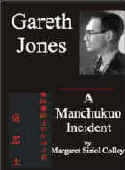Gareth Jones
[bas relief by Oleh Lesiuk]
HOME |
Stop Press |
Complete Soviet Articles & Background Information |
Précis of Gareth's
|
All Published Articles |
BOOKS
|
|
|
|
More Than Grain of Truth(2005) |
|
|
TOPICAL
'Are you Listening NYT?' U.N. Speech - Nov 2009 |
Gareth Recognised at Cambridge - Nov 2009 |
Reporter and the Genocide - Rome, March 2009 |
Order of Freedom Award -Nov 2008 |
Premiere of 'The Living' Documentary Kyiv - Nov 2008 |
Gareth Jones 'Famine' Diaries - Chicago 2008 |
Aberystwyth Memorial Plaque 2006 |
GENERAL
Scholarship Fund |
Site Map |
Links |
Legal Notices |
Sponsored Links |
Contact |
Does Japan Dominate Siam? |
|
||||||||
By Gareth
Jones
Bangkok,
Siam
April 1935
A
new fear has spread throughout the East. I heard it whispered in
Japan, rumoured in the Dutch East Indies and declared openly in
Singapore. It is the fear that Japan has a firm grip over the ten
millions of who live in Siam. “The
Japanese,” I was told in Java, ‘are pushing their Empire ever
further Southwards and Westwards. They want to have a stronghold
in Siam. They want to build a canal which would compare with the
Panama Canal and which would enable them to dominate the markets of
India and the power of the British in Asia. This Canal would be
the Kra Canal and would make Singapore into a bigger "white
elephant” than any owned by the Kings of Bangkok. They want to
be masters of the route from Asia to India and to Africa.” This
fear has spread to India and so great has it become that even a serious
paper like the Times of India wrote on April 11, 1935: “India has this
great interest, that the establishment of Japanese economic hegemony
over Siam would bring a new international influence into an area which
is contiguous with the frontier of Burma. In the past India’s
foreign and defense policies have been dictated by consideration of the
risk attaching to her North West frontier, where first the Russian
menace and later the Afghan unrest were present. Should a new
militant power establish itself on the eastern border of Burma,
India’s foreign and defense policies will need radical revision. When
the military authorities guarding the life and property of over three
hundred million people in India threaten to change their whole defense
on account of fear of Japan, the fear is one worth examining. Is
it justified? Does Japan
really dominate Siam?
To
answer this question I travelled to Bangkok, the capitol of Siam, where
huts of bamboo and straw jutting out of the river stand beneath the
shadows of gorgeous palaces and glittering temples. I spoke to the
Prime Minister and Foreign Minister, to the foreign representatives,
to the merchants, to advisers and professors. I shall write what I
found about Japanese influence in Siam, There
is certainly a growing friendship between Siam and Japan. Listen
to what a leading Japanese authority said to me: “We Siamese regard
Japan as an elder brother. We are an example to Siam of a
country which has freed itself from Western influences and which has
progressed rapidly. The young people here look up to the
Japanese and say: ‘If only we could do what they do’.” But
we are not a leader we are only a teacher of the Siamese and it is right
that we should play a big part among the Asiatic peoples.” This
talk recalled what a young Siamese student said to a friend of mine:
“We want to be the Japan of the South. Religion is another link between the Siamese and
the Japanese for both lands are Buddhist. Race is another.
The Siamese are growing more and more conscious that they are Asiatic
and the white powers, through their depression and decline and through
their mass murder of millions during the War have lost prestige.
There were Siamese soldiers fighting in Europe against Germans and they
returned with the tale of a bloody impoverished white race with its
members at each others’ throats. “We of the yellow race
are as good as you of the white race, is the thought that flashes
through the minds of the young Siamese. The result is that many
European advisers have left the country. That the Siamese State
railways, which formerly had many British experts and foremen has today
only one British worker and that Japanese experts are coming to take the
place of whites. Recently cotton experts came from Japan and there
are two Japanese officers of high rank in the Siamese in the Siamese
Army. There
are many signs of the growing friendship between the two Buddhist and
Asiatic countries. Many Siamese students now go to Japan.
Recently a number of Siamese naval cadets, abandoning the tradition that
the British Navy shall teach the future admirals of Siam, went to
receive their training in the Japanese fleet. The Siamese Boy Scouts
sent as a token of friendship two elephants, which were received with
rejoicing in Japan. A Siamese parliamentary commission has just
paid a visit to Nippon while prison experts have been peeping behind the
scenes in Japanese prisons to learn from their new teachers how to run
penitentiaries. In
1933 at Geneva Siam was the only country in the League of’ Nations
which refrained, from voting against Japan in the condemnation of
Japanese policy in conquering Manchuria. The Siamese newspapers
are greatly influenced by Japan, because their news comes mainly through
the official Japanese news agency, Rengo, and the editors lay great
stress upon the importance of Japan in the Far East. Japan’s
greatest advance is, however, in trade. As I walked down
Bangkok’s main street I saw a great advertisement for the “Datsun”
automobile made in Japan. I was angered for I had learned that last year
Japan had only exported one single automobile to Siam, and now a store
in the centre of the City had been opened for Japanese automobiles.
Entering the store I spoke to the salesman. “We are pushing
Japanese automobile which we sell than any other he declared.
Although there was only one Japanese auto bought last year we hope this
year to sell more and more. When we can sell in large quantities
we will, of course, reduce the price.” Japanese
automobiles in Siam! This is a sign of the growing Japanese grip
over many branches of trade. Japanese manufacturers lead the way
in Siam in radio accessories, silk, artificial silk, wire, paper,
bicycles, cement, rubber goods and blankets and Great Britain is the
greatest sufferer. It is in textiles, however, that Japan is going
ahead most rapidly. In 1932-3 Japan sold 15,725 dozen singlets to Siam.
Within one year that figure had increased seven-fold and 105,049 dozen
were sold. Imports of plain rayon leapt up three-fold in that
year. In 1932-3 the Japanese imported 947 bicycles into Siam. By
one year later they had imported 5,246 bicycles. Until
recently railway contracts in most countries in the Far East were always
given to European or American firms. This year however, a large
contract for the construction of railway bridges was given to Japan
although there were eleven foreign firms bidding. Do
these signs of friendship really mean, however, that Japan dominates
Siam? I do not think so. The Siamese have been affected so
much by the wave of nationalism which has swept the world that their cry
is first and foremost: “Siam for the Siamese!” In their new
burst of nationalism they are not willing to bow down before any
nation. While the cry “Asia for the Asiatics” affects some of them,
it is above all for themselves, the Siamese, that they fight and not for
the sake of Asia. They are afraid of being dominated by the
Japanese and they are too wise to place their fate in the hands of
Nippon, when they have the French on one side of them and the British on
the other. The
Siamese know that they have a vast population of Chinese who are the
businessmen of their country. The Chinese hate the Japanese and
would fight any policy of placing Siam beneath Japanese protection.
So much do the Chinese loathe the Japanese that when the Japanese troops
marched through Manchuria the Chinese servant boys four thousand miles
away, in some families in Bangkok smashed joyfully all the Japanese
crockery in the houses, while the store keepers refused to buy or sell
Japanese goods. The
Kra Canal is one of the biggest myths of the century and must be
debunked. For the Japanese to build a canal in Siamese territory across
the Isthmus of Kra would cost a vast amount of capital. London would
never lend the money for an anti-British scheme. Wall Street would
not be so foolish as to put its finger in the pie. Tokyo is too
impoverished to finance the Canal. Even if by some financial
miracle the money were forthcoming, the Canal would be a failure,
because no vessel would pay vast dues to save only two day’s voyage
and many ships round South Africa in order to save the dues on the Suez
Canal. Nor would captains avoid such a rich free-trade port as
Singapore, where they can pick up valuable freight. No, Singapore
can rest calm as a symbol that Britain dominates the North from the
Pacific to India. “Britain”
is the final barrier to Japan in trying to gain domination over Siam.
British advisers still quietly control the finances of Siam and the
Siamese money, which has the comic name of “ticul” (about 50c) is
linked with sterling. “Does Japan dominate Siam?” I asked a leading
Englishman in Bangkok. He laughed quietly: “Have you any Siamese
money? he asked. I drew out a five-ticul note (about 2 dollars 50
c). “Read what is printed at the foot of the note,” he
commanded. I read, “Thomas de la Rue and Co., London”. With
calm confidence he said: “As long as the word ‘London’ stands on
that Siamese bill, it is not Japan but another little island which will
have the larger say in the Kingdom of Siam.” I think he was right in spite of growing Japanese Siamese friendship the rumour that Japan dominates Siam is one of the scares with which Asia is swarming. |
GARETH JONES (1905 -35) |
||||||||
|
|||||||||




